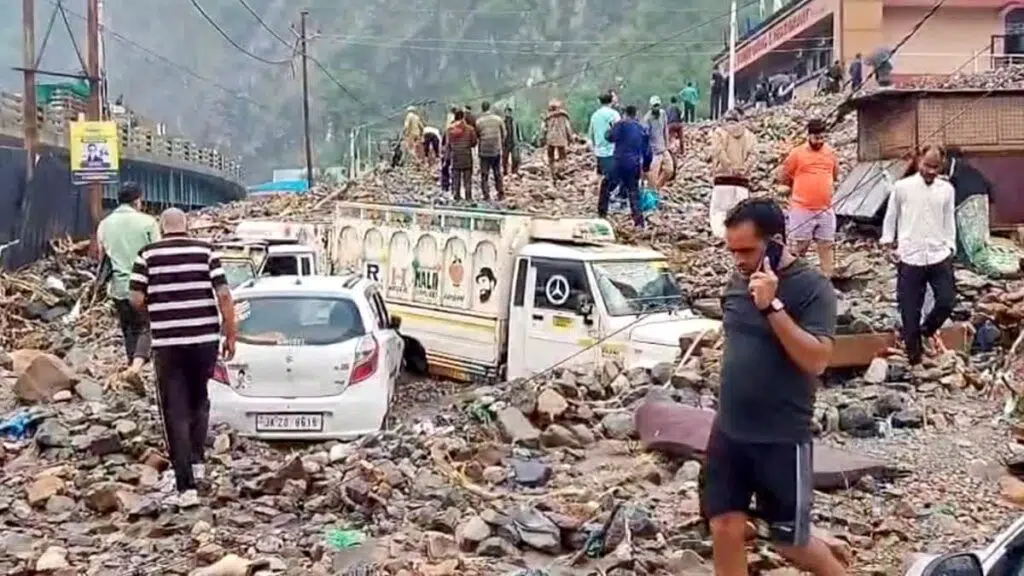Jammu Kashmir cloudburst landslide incidents have claimed eleven lives in devastating natural disasters. Saturday morning brought twin tragedies to the mountain regions. Additionally, these catastrophic events underscore the region’s vulnerability to extreme weather patterns. Furthermore, rescue operations continue across both affected districts while authorities assess the extensive damage.

Ramban District Hit by Deadly Flash Floods
Three villagers lost their lives when violent flash floods struck Rajgarh tehsil. Moreover, five people remain missing after the Jammu Kashmir cloudburst landslide triggered massive water surges. Consequently, rescue teams rushed immediately to the disaster zone.
“As of now, there are reports that five people are unaccounted for. We are searching for them. The flash floods have also damaged property in the area,” an official said
The cloudburst occurred during the early morning hours. Subsequently, torrential rains created dangerous conditions across the mountainous terrain. Meanwhile, search operations continue despite challenging weather conditions.
Property damage extends throughout the affected villages. Indeed, several houses suffered complete destruction from the raging waters. Nevertheless, emergency response teams maintain their life-saving efforts.
Reasi Tragedy Claims Entire Family
A separate landslide buried seven family members in Mahore area. Tragically, the victims included parents and five children under twelve years old. Furthermore, the house collapsed completely under massive debris at 3 AM.
The Jammu Kashmir cloudburst landslide event devastated the Badar village community. Subsequently, rescue workers spent hours extracting bodies from the wreckage. However, all family members had already perished before help arrived.
“We have launched a rescue operation, but we have yet to recover any bodies,” an official said.
Local authorities deployed multiple rescue agencies to the scene. Additionally, State Disaster Response Force teams worked alongside police units. Therefore, comprehensive search operations ensured thorough debris clearance.
Pattern of Destruction Across the Region
Over the past fortnight, extreme weather devastated Jammu Kashmir extensively. Specifically, cloudbursts and landslides killed more than 115 people throughout the region. Consequently, most victims were religious pilgrims visiting sacred sites.
The August 14 Kishtwar disaster claimed sixty-five pilgrim lives. Similarly, thirty pilgrims died near Mata Vaishno Devi shrine on August 26. Therefore, these Jammu Kashmir cloudburst landslide incidents demonstrate increasing weather volatility.
“Because of the prevalent cycle of monsoon as well as western disturbances, the interaction is proving deadly and this could continue and people need to remain cautious and vigilant,” administrative sources explained.
Infrastructure collapse accompanies each devastating weather event. Furthermore, roads, bridges, and communication systems suffer extensive damage. Meanwhile, economic losses reach thousands of crores across the region.
Emergency Response and Rescue Operations
Multiple agencies coordinate ongoing relief efforts throughout both districts. Notably, Indian Air Force helicopters conduct aerial rescue missions. Additionally, National Disaster Response Force teams provide ground support.
The rescue operations face significant logistical challenges. Moreover, continuous rainfall hampers access to remote areas. Nevertheless, teams persist despite dangerous working conditions.
Transportation networks remain severely compromised across the region. Specifically, the Jammu-Srinagar National Highway stays closed for consecutive days. Consequently, thousands of vehicles remain stranded along major routes.
“Operations have enabled the rescue of 215 individuals and delivered 7,300 kgs of essential relief material in the affected areas in the past three days,” the Defence Ministry reported.
Emergency shelters provide temporary accommodation for displaced families. Additionally, food, water, and medical supplies reach affected communities. Therefore, humanitarian assistance continues despite challenging circumstances.
Government Investigation and Prevention Measures
Authorities established a committee to investigate recent landslide incidents. Specifically, the panel will examine causes and assess emergency response effectiveness. Furthermore, officials must recommend preventive measures within two weeks.
Union Home Minister Amit Shah plans a comprehensive assessment visit. Additionally, he will conduct aerial surveys of flood-affected areas. Therefore, high-level government attention focuses on the crisis.
“The government on Friday announced a committee to probe the landslide deaths at the Katra shrine and to find the cause of the landslide, assess response in the form of rescue and relief, and suggest SOPs to prevent the recurrence of such incidents,” officials confirmed.
Weather forecasting systems require immediate improvement throughout the region. Moreover, early warning mechanisms must reach vulnerable communities effectively. Subsequently, disaster preparedness protocols need comprehensive revision.
The Jammu Kashmir cloudburst landslide events highlight climate change impacts. Indeed, extreme weather patterns increasingly threaten mountain communities. Therefore, long-term adaptation strategies become essential for regional safety.
Weather Warnings and Future Preparedness
Meteorological departments issued multiple alerts for continued severe weather. Specifically, orange warnings cover Poonch, Kishtwar, Jammu, Ramban, and Udhampur districts. Additionally, thunderstorms and lightning pose ongoing threats.
Educational institutions remain closed throughout the Jammu division until August 30. Furthermore, authorities advise residents in vulnerable areas to exercise extreme caution. Therefore, public safety measures prioritize life preservation.
The threat of additional Jammu Kashmir cloudburst landslide incidents continues. Moreover, weather experts predict unstable conditions through September 5. Consequently, communities must maintain constant vigilance.
Relief camps provide essential services for displaced populations. Additionally, medical teams treat injured survivors across multiple locations. Nevertheless, psychological support becomes equally important for trauma recovery.
Economic Impact and Recovery Challenges
The financial toll from these disasters reaches astronomical proportions. Property damage alone accounts for thousands of crores in losses. Moreover, agricultural lands suffer extensive flooding throughout the region.
Tourism, a vital economic sector, faces severe disruption. Specifically, pilgrimage routes to major shrines remain suspended indefinitely. Consequently, local businesses dependent on religious tourism struggle significantly.
Railway services experience massive cancellations affecting passenger transport. Additionally, freight movement stops completely on damaged tracks. Therefore, economic recovery requires extensive infrastructure reconstruction.
“Heavy rains and floods triggered by the heavy rain and cloudbursts have damaged property worth thousands of crores in the region,” officials reported.
The Jammu Kashmir cloudburst landslide disasters demand comprehensive rehabilitation planning. Furthermore, reconstruction efforts must incorporate improved disaster-resistant designs. Additionally, community resilience building becomes crucial for future preparedness.
These tragic events underscore the urgent need for enhanced weather monitoring systems. Moreover, early warning networks must reach even the most remote villages. Therefore, investment in disaster preparedness infrastructure becomes a critical priority for preventing future Jammu Kashmir cloudburst landslide casualties.





